
Ponerinae, the ponerine ants, is a subfamily of ants in the Poneromorph subfamilies group, with about 1,600 species in 47 extant genera, including Dinoponera gigantea - one of the world's largest species of ant. Mated workers have replaced the queen as the functional egg-layers in several species of ponerine ants. In such queenless species, the reproductive status of workers can only be determined through ovarian dissections.

Gesomyrmex pulcher is an extinct species of ant in the subfamily Formicinae known from an Eocene fossil found in Europe. G. pulcher is one of only eight species in the ant genus Gesomyrmex to have been described from fossils found in Europe.
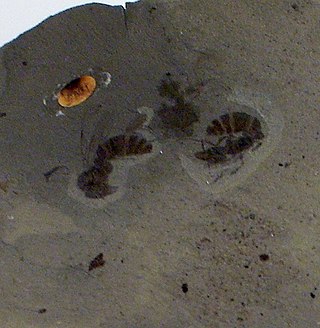
Ypresiomyrma is an extinct genus of ants in the subfamily Myrmeciinae that was described in 2006. There are four species described; one species is from the Isle of Fur in Denmark, two are from the McAbee Fossil Beds in British Columbia, Canada, and the fourth from the Bol’shaya Svetlovodnaya fossil site in Russia. The queens of this genus are large, the mandibles are elongated and the eyes are well developed; a stinger is also present. The behaviour of these ants would have been similar to that of extant Myrmeciinae ants, such as solitary foraging for arthropod prey and never leaving pheromone trails. The alates were poor flyers due to their size, and birds and animals most likely preyed on these ants. Ypresiomyrma is not assigned to any tribe, and is instead generally regarded as incertae sedis within Myrmeciinae. However, some authors believe Ypresiomyrma should be assigned as incertae sedis within Formicidae.

The Messel Formation is a geologic formation in Hesse, central Germany, dating back to the Eocene epoch. Its geographic range is restricted to the Messel pit. There it unconformably overlies crystalline Variscan basement and its Permian cover (Rotliegend) as well as Eocene volcanic breccias derived from the basement rocks. The formation mainly comprises lacustrine laminated bituminous shale renowned for its content of fossils in exceptional preservation, particularly plants, arthropods and vertebrates.
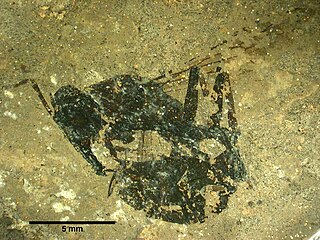
Archimyrmex is an extinct genus of ant in the formicid subfamily Myrmeciinae, described by palaeoentomologist Theodore Cockerell in 1923. The genus contains four described species, Archimyrmex rostratus, Archimyrmex piatnitzkyi, Archimyrmex smekali and Archimyrmex wedmannae. Archimyrmex is known from a group of Middle Eocene fossils which were found in North America, South America, and Europe. The genus was initially placed in the subfamily Ponerinae, but it was later placed in Myrmeciinae; it is now believed to be the ancestor of the extant primitive genus Myrmecia from Australia. Despite this, Archimyrmex is not a member to any tribe and is regarded as incertae sedis within Myrmeciinae. However, some authors believe Archimyrmex should be assigned as incertae sedis within Formicidae. These ants can be characterised by their large mandibles and body length, ranging from 13.2 to 30 mm. They also have long, thin legs and an elongated mesosoma (thorax) and petiole.

Archiponera is an extinct genus of ant in the formicid subfamily Ponerinae. The genus contains a single described species, Archiponera wheeleri known from several Late Eocene fossils which were found in North America.

Emplastus is an extinct morphogenus of ants in the subfamily Dolichoderinae, known from fossils found in Asia and Europe. The genus contains twelve species described from sites in England, Eastern Europe and Far Eastern Russia.

Casaleia is an extinct genus of ants in the formicid subfamily Amblyoponinae described by Pagliano & Scaramozzino in 1990 from fossils found in Europe. The genus contains four species dating from the Eocene to Miocene, Casaleia eocenica, Casaleia inversa, Casaleia longiventris, Casaleia orientalis.

Pseudectatomma is an extinct genus of ants in the formicid subfamily Ectatomminae described by from fossils found in Europe. The genus contains two species dating from the Eocene, Pseudectatomma eocenica and Pseudectatomma striatula.

Pachycondyla eocenica is an extinct species of ant in the formicid subfamily Ponerinae described from fossils found in Europe. P. eocenica is one of six Lutetian Pachycondyla species.

Pachycondyla lutzi is an extinct species of ant in the formicid subfamily Ponerinae described by from fossils found in Europe. P. lutzi is one of six Lutetian Pachycondyla species.
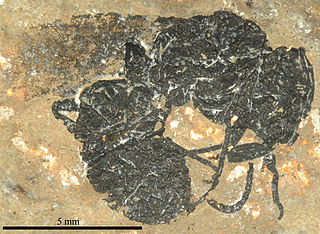
Pachycondyla? messeliana is an extinct species of ants in the formicid subfamily Ponerinae described by from a fossil found in Europe. P.? messeliana is one of six Lutetian Pachycondyla species.

Pachycondyla parvula is an extinct species of ant in the formicid subfamily Ponerinae described by from a fossil found in Europe. P. parvula is one of six Lutetian Pachycondyla species.

Pachycondyla petiolosa is an extinct species of ant in the formicid subfamily Ponerinae described by from a fossil found in Europe. P. parvula is one of six Lutetian Pachycondyla species.
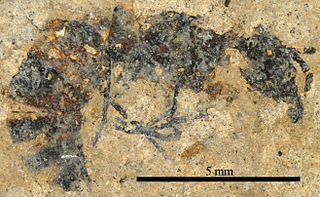
Pachycondyla petrosa is an extinct species of ant in the formicid subfamily Ponerinae described from a fossil found in Europe. P. petrosa is one of six Lutetian Pachycondyla species.

Protopone is an extinct genus of ants in the formicid subfamily Ponerinae described from fossils found in Europe and Asia. There are seven described species placed into the genus, Protopone? dubia, Protopone germanica, Protopone magna, Protopone oculata, Protopone primigena, Protopone sepulta, and Protopone vetula. Protopone is one several Lutetian Ponerinae genera.
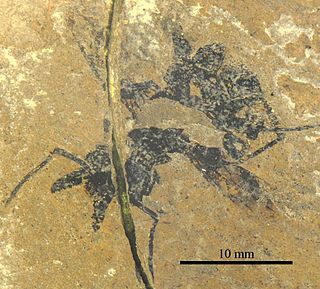
Cephalopone is an extinct genus of ants in the formicid subfamily Ponerinae described from fossils found in Europe. There are two described species placed into the genus, Cephalopone grandis and Cephalopone potens. Cephalopone is one several Lutetian Ponerinae genera.

Messelepone is an extinct genus of ants in the formicid subfamily Ponerinae described from fossils found in Europe. M. leptogenoides is the only species assigned to the genus, which is one of several Lutetian Ponerinae genera.
Aneuretellus is an extinct genus of ant in the formicid subfamily Aneuretinae, and is one of eight genera of the subfamily. The genus contains a single described species Aneuretellus deformis and is known from one Middle Eocene fossil which was found in Sakhalin in the Russian Far East.

Bradoponera is an extinct genus of ant in the Formicidae subfamily Proceratiinae, and is one of four genera of the subfamily. The genus contains four described species Bradoponera electrina, Bradoponera meieri, Bradoponera similis, and Bradoponera wunderlichi. The species are known from several Middle Eocene amber fossils which were found in Europe.






















